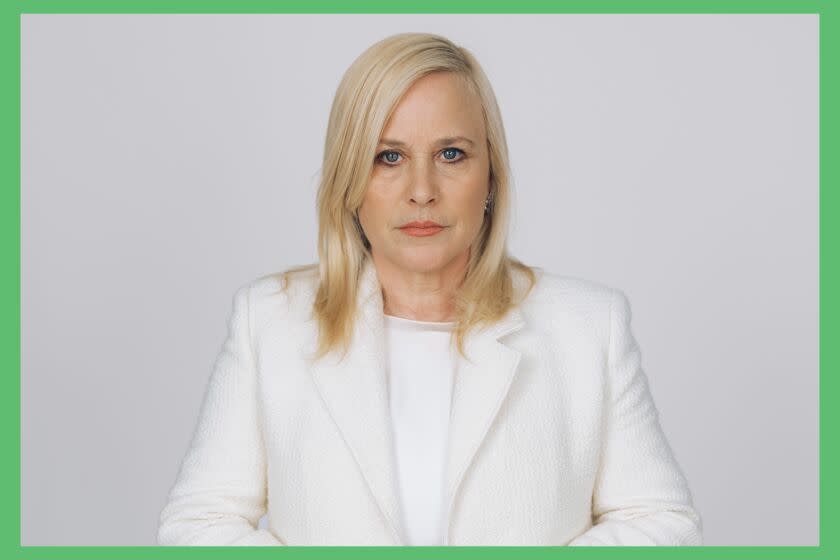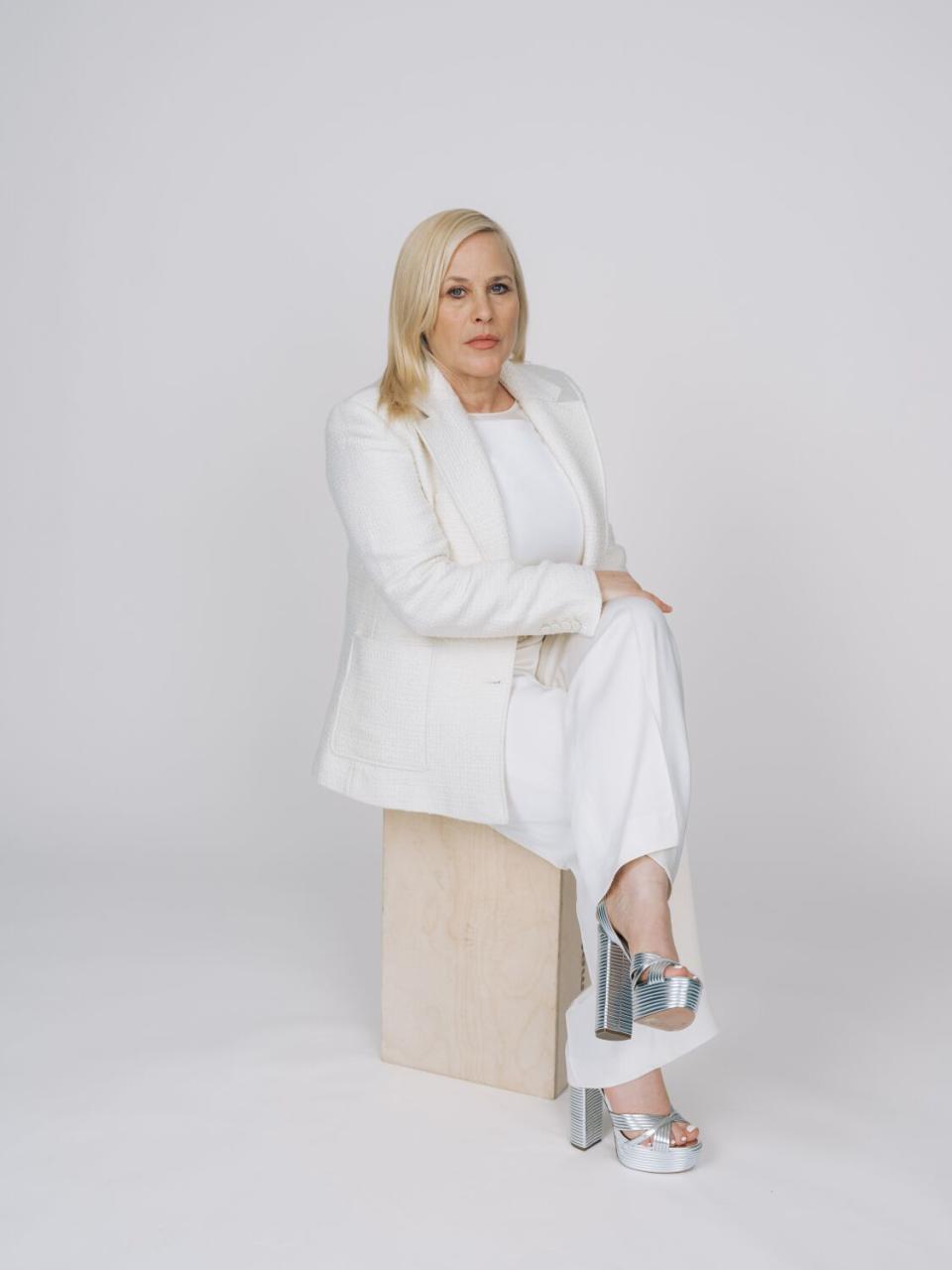Patricia Arquette is at home among Yucca Valley's fringe characters in 'High Desert'

- Oops!Something went wrong.Please try again later.
Bringing strong and complicated personalities to life on screen is Patricia Arquette’s superpower, as evidenced in films such as “Boyhood” and TV dramas like “The Act” and “Severance.” Now Arquette is turning her talents toward comedy with “High Desert,” a quirky, character-driven series premiering May 17 on Apple TV+ that’s set among the casinos and cactuses around Yucca Valley.
Arquette plays Peggy Newman, a former drug dealer who still partakes in the products she used to sell. Though she’s happy enough with her job as a costumed cancan dancer in a Wild West theme park, necessity drives her toward a new career: private investigator. When her messy life and cases collide, the series brims with an array of colorful desert dwellers, from a former news anchor turned spiritual guru to the gambling ladies of drag bingo.
Newman is a hoot: She tools around town in a dune buggy, procures lunch by stealing other people's DoorDash orders and fakes IBS more than once to get out of a fix. But behind the wily blond hair and bluster, she’s grappling with her mother's death and her own addiction issues. Written by Nancy Fichman, Katie Ford and Jennifer Hoppe, “High Desert” features Bernadette Peters as Newman’s late mother, Rosalyn, and Matt Dillon as her charming, parolee husband, Denny.
Arquette, 55, spoke to The Times about "High Desert" and her penchant for playing outsiders.
“High Desert” is a fantastically eccentric series that's driven by Peggy's wild spirit, so it goes to all sorts of unexpected places.
It's a counterculture comedy with all these highs and lows. It's a story about this woman who is struggling with drug addiction and is going through a sober-ish period in her life. She's trying to hustle and use all of her skills to get her needs met and make some money. And she's one of these people that's living in this fringe world of the desert. It’s where a lot of people end up gravitating, people who look at life a little differently.
From its casinos to Pioneertown, the high desert is almost a character unto itself in this series.
For sure. And [Peggy’s sister Dianne], which is Christine Taylor’s character, is the other part of the desert — the spas and the golf course and the Mercedes and the wealthy people. And then there’s these fringe-y kind of people. In a way, Peggy and Denny are like cacti or coyotes or Gila monsters. They’re desert creatures.
The death of Peggy's mother has a profound impact on her and she doesn't really have the support of family: Her husband is in and out of prison and her siblings aren’t there for her. So she's immersed herself in a community of fellow oddballs, like Guru Bob (Rupert Friend).
All these characters want a family or connection with each other, so she picks up these broken birds under her wing, but she also makes a lot of dumb decisions. Like, very criminal. And she really loves her [husband], but she knows she shouldn't be with him. But he's also the only person who really would risk his life for her. So it's very complicated. I think she's a reluctant hero. ... But all the turns [in "High Desert"] are coming from these characters’ needs and their weird ways of looking at the world.
Peggy is flaky yet loyal, scattered but determined, tough but incredibly fragile. It’s hard to imagine anybody else playing her but you. Was the role made with you in mind?
I think they wrote it many, many years ago, and then they revisited it. [When] they brought it to me, we went back and forth on it, and changed it a lot. … Of all of these different projects, I feel like I had the most impact on making [this one] happen before we shot. Like giving writing notes, helping get set up, helping to pitch and make it happen. I do feel some ownership in that part of this process. … I kind of helped birth this thing into the world, and I’m really proud of that because I recognize that these women were incredibly talented and they were telling a very interesting story. When Apple picked it up, we were, like, thank you!

Struggling with addiction is a central theme here, and even though Peggy's often a cluttered heap, she's afforded respect.
Peggy was inspired by Nancy [Fichman], who lost her sister Marjorie. I had also known a lot of addicts growing up, who died and who had wonderful, beautiful, incredible qualities. They were brilliant people, but also they would steal your guitar when you turned around.
Drug addiction isn't always treated with such nuance on television.
Yeah, I think we're really not there yet when looking at addiction, the way that we ought to be, looking at the fullness of the person — and that it is an illness. [It’s still] treated it like it's this character flaw. And it's painful to love somebody who's a drug addict, and your life does become more and more messy as you go along when that's your choice. But again, we had loved and lost people like that. And the great loss is all their genius, and all of their beauty and their sweet hearts and all of the things that you lose when you lose them.
Loss is another theme that underpins the series.
Though the series was fun to do, it was also sad. I'd lost my sister Alexis, who'd always kind of gathered these broken bird people. And I'd lost my mom, [so] there was a lot of crossover. That deeper stuff was there. We wanted to celebrate all these people we loved even though we knew they were disasters.
Peggy’s actions, good and bad, are very much a reaction to the grief she feels over the loss of her mother.
She's going through a lot of self-avoidance. Her moving and keeping hustling is really about picking up this broken person's thing. Oh, and you're sad about your life? OK, let me fix that too. Let me not look at my pain I'm in. Let me keep it moving and keep distracting myself from all this stuff. I think that that's a part of avoidance — looking at your addiction and the pain underneath your addiction.
An important part, which maybe is a spoiler, is that Peggy was pushed into a parental position as an adolescent. She took on the responsibility of both her siblings and also her mother, who is very childlike. So she wasn't completely mature. She hustled as a 16-year-old, the way a 16-year-old does. So there's a part of her now that's in an arrested state.
You've portrayed so many complex characters. Your roles in “Escape at Dannemora” and “Severance” are great examples. How long did it take you to get to that place where you were able to land these really unique roles, especially in industries that often marginalize women?
I've had tremendous luck all along the line, every inch of the way, every second of the day. All the way from starting as a young woman to each director that I worked with to knowing that I wanted to break out of that ingénue thing as quickly as I could. Also, having a kid early, I knew I had to hustle. I have to be good at this because I have a human to feed. I need to work. I cannot drop the ball. I think that really propelled me to work harder. Inexplicably, I've had a lot of opportunities that on paper I shouldn't have had, I guess.
You crossed over from movies into TV around 2005 with “Medium,” and that was a time when most film actors were not willing to make that jump. Do you think that helped expand the types of roles that came your way?
I wanted to do TV because I kind of saw the writing on the wall with movies and [thought] why can't we do good work on TV? I want to test that theory. My great-grandparents were in vaudeville. The closest I can get [to that] is network TV. And then everyone started doing TV. But I'd kind of already established something. So it was always kind of a lot of good luck and open doors for me.
Still, people don't really associate you with comedy. Was that of concern with "High Desert"?
For sure. I haven't got to do a lot of comedy, nor do I think it's necessarily my strong suit. But I want to grow as an actor all the time. And I do love this character. The way that they write is very funny, but without a "ha-ha" setup joke.
Bernadette Peters is a joy to watch. What was it like working with her?
Just unbelievable. I mean, my mom had a little light, girlish quality. And when Nancy talks about her mom, I hear that in it. I was a little intimidated working with Bernadette, but she's just so warm and sweet and incredibly talented. It was really a dream come true to be able to work with her.
And Matt Dillon is so charming as an ex-con. It’s easy to see why Peggy can't keep away from him. They have chemistry.
The weird thing is that we've never worked together. But as a kid I watched him [in films]. We all crushed on Matt Dillon! I almost felt like when I was watching him — he was like the kids I grew up with riding big wheels and bikes, playing tag, stealing candy from the store. So then when we did “High Desert,” it felt like [we] had known each other for a long time.
What's next for you?
I just directed my first thing. It’s a movie called “Gonzo Girl” with Willem Dafoe and Cami [Camila] Morrone. It was a very humbling and a huge learning process. I have so much respect for directors. I thought that my strength would be communicating with actors, but I found that wasn't necessarily the case. I learned a lot, looking at different actors' processes and strengths. I've worked with actors my whole life, but to really scrutinize it as a director, their process, I was looking at it in a different way. My favorite thing was being able to say I'm going to edit this whole movie for the acting. I don't care if it's soft focus, a weird shot, not the best angle, not the best lighting. I am always going to choose the best acting. That's my true north.
This story originally appeared in Los Angeles Times.

